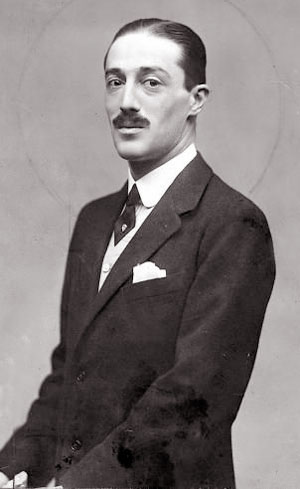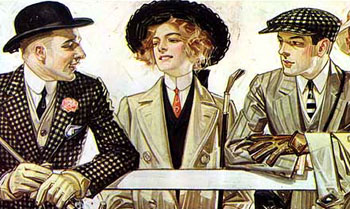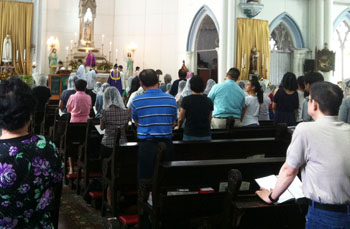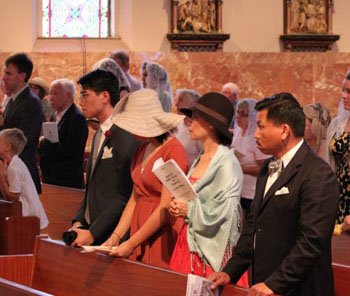Manners, Customs, Clothing
 |
 |
 |
 |
 |
 |
 |
The History of the Tie - II
The Necktie: The Symbol & Uniform
of a Counter-Revolutionary Man
After dealing generically with the history of the necktie in Fashion, I will start to apply the principles from Dr. Plinio Corrêa de Oliveira’s
Revolution vs. Counter-Revolution to its use.
 As Christendom developed, hierarchy and sacrality became two essential foundations of society, which were reflected in its tendencies, ambiences, customs and culture. It is precisely this hierarchy and sacrality that the Revolution has sought to destroy since its inception.
As Christendom developed, hierarchy and sacrality became two essential foundations of society, which were reflected in its tendencies, ambiences, customs and culture. It is precisely this hierarchy and sacrality that the Revolution has sought to destroy since its inception.
The necktie is a symbol of these two things; thus, it became a target for the Revolution, which sought to destroy them by trying to eradicate the necktie from the quotidian life of man.
Hierarchy & sacrality vs. egalitarianism & vulgarity
As Dr. Plinio explained, hierarchy is written on our very souls: “God, who imprinted a hierarchical mark on all visible and invisible creation, did the same on the human soul. The intelligence should guide the will, and the latter should govern the sensibility.” (Revolution & Counter-Revolution, York, PA: 1993, p. 51)
This hierarchy within us is also around us, since it was planted into all of Creation by God. Anyone who denies that hierarchy exists not only revolts against nature, but revolts against God himself. This is why revolutionaries have habitually attacked hierarchy and violently promoted egalitarianism since the Protestant Revolt in the 16th century, and onwards.
Egalitarianism reached its logical consequence in the 20th century, with the equality of the sexes promoted since the early 1900s. Androgyny in fashion, a natural corollary, crept in slowly, beginning with the advertising of women’s neckties, followed by the advent of women’s trousers in the ‘20s and ‘30s. The trend continued with the Cultural Revolution of the ‘60s, which introduced even more egalitarian and immodest fashions. Today, we see this leveling of sexes being promoted constantly, especially with the new militant transgender and homosexual movements sweeping our nation.
 Something similar took place with regard to sacrality. This sacrality – inherent in Christian society – created ambiences that inclined one to the sacred. A sacral state of spirit permeated not just ambiences in the spiritual sphere, but also those in the temporal world – the public square and buildings, the home and its décor and, of course, the clothing worn by both men and women.
Something similar took place with regard to sacrality. This sacrality – inherent in Christian society – created ambiences that inclined one to the sacred. A sacral state of spirit permeated not just ambiences in the spiritual sphere, but also those in the temporal world – the public square and buildings, the home and its décor and, of course, the clothing worn by both men and women.
Sacrality in its natural state is dignity; it is a seriousness that does not exclude joy, but leaves behind all that is vulgar, base and banal. Sacrality in Christian society is found in man's tendency to make everything reflect God in some way. This wise practice nurtured by Christian Civilization facilitates the practice of virtue and the salvation of souls.
Vulgarity is the exact opposite: Since it is a reflection of a mindset that considers man – and not God – to be the center of life, everything revolves around satisfying the pleasure of the senses or sensuality. Comfort rather than dignity reigns supreme, which is followed by the desire to embrace the casual and reject everything that demands effort and reflects man's dignity as a creature of God.
The vulgar revolution in clothing today turns man toward himself, toward enjoying life, toward comfort and ease. We see this in the current fashions that are being embraced by young and old: T-shirts, jeans and even crocs.
The necktie, hierarchy & sacrality
In men’s clothing, the necktie might be called the realization of hierarchy and sacrality:
Hierarchy, because to wear a necktie is inherently anti-egalitarian. Since only men use neckties, it affirms the inequality of the sexes. It also admits a social order inherent in our world, since the necktie distinguishes those engaged in higher levels of work.
 One might ask: How is this so? Despite the vicious advancement of the homosexual and transgender movements in our day and age, the reality is that our Western culture still acknowledges the inherent masculinity in the wearing of a necktie. For this reason, it is rare to see women wearing neckties.
One might ask: How is this so? Despite the vicious advancement of the homosexual and transgender movements in our day and age, the reality is that our Western culture still acknowledges the inherent masculinity in the wearing of a necktie. For this reason, it is rare to see women wearing neckties.
In fact, despite the attempts of feminists to dress like men, they generally have not donned the necktie in the public sphere. It seems an almost untouchable ground for the modern feminist. Thus, for a man to wear a necktie is to implicitly acknowledge his own masculinity and also to encourage and promote the inequality of the sexes and hierarchy.
For anyone skeptical of the inherent masculinity in necktie-wearing, I suggest Googling the word “gentleman”; then, take note of how many pictures appear of men wearing neckties.
To wear a necktie is also to promote sacrality. Since there is an element of dignity and honor in the tie, an inevitable seriousness flows from it.
There is also a sense of duty that is reflected in this practice. Because the tie is viewed today as something uncomfortable, an unspoken statement is made when a man wears a tie: His very appearance states that there are things more important in life than comfort. (The aspect of actual vs. perceived comfort in this issue can be debated, since some men accustomed to the practice assert that wearing a necktie is actually not uncomfortable).
A necktie supposes the coat
Another hugely important aspect of dignity comes into play here: A necktie demands a complete dignity, to such an extent that a necktie without a coat is incomplete. Regardless of what others claim (including those with ecclesiastical authority), it is clear that wearing a necktie without a coat looks childish, and to wear a coat without a necktie looks unceremonious.
 Of course, there are exceptions to this rule, but it is always in provisory and transitional situations. For example, wearing a necktie without a coat would be permissible if a man takes off his coat when working in a kitchen or going outdoors to garden or to barbecue. Clearly, he must take off his jacket to put on a white lab coat when he is making laboratory tests. Wearing a coat without a tie would also have its exceptions, such as when returning to society after playing golf or tennis, boating and the like.
Of course, there are exceptions to this rule, but it is always in provisory and transitional situations. For example, wearing a necktie without a coat would be permissible if a man takes off his coat when working in a kitchen or going outdoors to garden or to barbecue. Clearly, he must take off his jacket to put on a white lab coat when he is making laboratory tests. Wearing a coat without a tie would also have its exceptions, such as when returning to society after playing golf or tennis, boating and the like.
This idea of a tie’s complete dignity applies to a man's entire costume, not just the coat. Hence, to wear a tie with a short-sleeve shirt looks ridiculous; it is even more ridiculous when a man wears a tie with shorts.
Exceptions here occur in provisory and transitional situations, but in all public situations, to wear a tie means one must invest in the complete dignity of the entire outfit, which means long-sleeved shirts (white or light color normally), long trousers and leather shoes. This is what is considered traditional dress for the man. The dispute of belt vs. suspenders is a different story entirely, which I leave to discuss on another occasion.
Clothing & semi-counter-revolutionaries at Sunday Mass
If we truly desire to fight the Revolution in the Church and society, it is not enough just to attend the Tridentine Mass or be politically "conservative," as some naively purport. We must aim to be counter-revolutionaries, starting with the simplest and most modest means: our clothing.

 Many men admit this principle for women, calling for them to wear skirts and appear with a feminine dignity at all times. But they dismiss the responsibility they have to respect their own dignity and the hierarchy of Catholic society by wearing the casual and "easy" clothing flaunted everywhere today.
Many men admit this principle for women, calling for them to wear skirts and appear with a feminine dignity at all times. But they dismiss the responsibility they have to respect their own dignity and the hierarchy of Catholic society by wearing the casual and "easy" clothing flaunted everywhere today.
Such men would be what Dr. Plinio calls “semi-counter-revolutionaries.” These are people who “might conserve a counter-revolutionary attitude in respect to one or many points due to an interplay of circumstances and coincidences, such as being reared in a strongly traditional and moral milieu. Nevertheless, the spirit of the Revolution will still be enthroned in their mentality." (Ibid, p. 60)
These semi-counter-revolutionaries are rampant in the traditionalist movement. They are the people who have a strong devotion to the Sacraments, Our Lady or even veneration of some saint but because they knowingly or unknowingly embrace some aspects of the Revolution, they appear, for example at Sunday Mass (the solemnest of occasions), with no tie or coat, but simply in a “nice” shirt and trousers.
In doing this, they accede to the egalitarian and vulgar principles of the casual Revolution in clothing and, thus, act as conscious or unconscious puppets for its ongoing conquest of the Church and society. Most importantly, they pay a grave disrespect to Our Lord in the Blessed Sacrament, because they not only trample the hierarchy and sacrality that He himself taught us to live by, but they dethrone God by placing themselves with their own comfort in the center of importance.
Continued

Posted September 18, 2017

An elegant Jacobo Fitz-James Stuart, Duke of Alba, in normal dress
The necktie is a symbol of these two things; thus, it became a target for the Revolution, which sought to destroy them by trying to eradicate the necktie from the quotidian life of man.
Hierarchy & sacrality vs. egalitarianism & vulgarity
As Dr. Plinio explained, hierarchy is written on our very souls: “God, who imprinted a hierarchical mark on all visible and invisible creation, did the same on the human soul. The intelligence should guide the will, and the latter should govern the sensibility.” (Revolution & Counter-Revolution, York, PA: 1993, p. 51)
This hierarchy within us is also around us, since it was planted into all of Creation by God. Anyone who denies that hierarchy exists not only revolts against nature, but revolts against God himself. This is why revolutionaries have habitually attacked hierarchy and violently promoted egalitarianism since the Protestant Revolt in the 16th century, and onwards.
Egalitarianism reached its logical consequence in the 20th century, with the equality of the sexes promoted since the early 1900s. Androgyny in fashion, a natural corollary, crept in slowly, beginning with the advertising of women’s neckties, followed by the advent of women’s trousers in the ‘20s and ‘30s. The trend continued with the Cultural Revolution of the ‘60s, which introduced even more egalitarian and immodest fashions. Today, we see this leveling of sexes being promoted constantly, especially with the new militant transgender and homosexual movements sweeping our nation.

An early feminist mimicking men by wearing a tie, vest & coat
Sacrality in its natural state is dignity; it is a seriousness that does not exclude joy, but leaves behind all that is vulgar, base and banal. Sacrality in Christian society is found in man's tendency to make everything reflect God in some way. This wise practice nurtured by Christian Civilization facilitates the practice of virtue and the salvation of souls.
Vulgarity is the exact opposite: Since it is a reflection of a mindset that considers man – and not God – to be the center of life, everything revolves around satisfying the pleasure of the senses or sensuality. Comfort rather than dignity reigns supreme, which is followed by the desire to embrace the casual and reject everything that demands effort and reflects man's dignity as a creature of God.
The vulgar revolution in clothing today turns man toward himself, toward enjoying life, toward comfort and ease. We see this in the current fashions that are being embraced by young and old: T-shirts, jeans and even crocs.
The necktie, hierarchy & sacrality
In men’s clothing, the necktie might be called the realization of hierarchy and sacrality:
Hierarchy, because to wear a necktie is inherently anti-egalitarian. Since only men use neckties, it affirms the inequality of the sexes. It also admits a social order inherent in our world, since the necktie distinguishes those engaged in higher levels of work.

A common sight today: grown men in shorts, un-tucked shirts and androgynous 'crocs'
In fact, despite the attempts of feminists to dress like men, they generally have not donned the necktie in the public sphere. It seems an almost untouchable ground for the modern feminist. Thus, for a man to wear a necktie is to implicitly acknowledge his own masculinity and also to encourage and promote the inequality of the sexes and hierarchy.
For anyone skeptical of the inherent masculinity in necktie-wearing, I suggest Googling the word “gentleman”; then, take note of how many pictures appear of men wearing neckties.
To wear a necktie is also to promote sacrality. Since there is an element of dignity and honor in the tie, an inevitable seriousness flows from it.
There is also a sense of duty that is reflected in this practice. Because the tie is viewed today as something uncomfortable, an unspoken statement is made when a man wears a tie: His very appearance states that there are things more important in life than comfort. (The aspect of actual vs. perceived comfort in this issue can be debated, since some men accustomed to the practice assert that wearing a necktie is actually not uncomfortable).
A necktie supposes the coat
Another hugely important aspect of dignity comes into play here: A necktie demands a complete dignity, to such an extent that a necktie without a coat is incomplete. Regardless of what others claim (including those with ecclesiastical authority), it is clear that wearing a necktie without a coat looks childish, and to wear a coat without a necktie looks unceremonious.

Left, a ridiculous 'hipster; middle, a casual youth looking foolish; right, Raulph Lauren promoting the trend
This idea of a tie’s complete dignity applies to a man's entire costume, not just the coat. Hence, to wear a tie with a short-sleeve shirt looks ridiculous; it is even more ridiculous when a man wears a tie with shorts.
Exceptions here occur in provisory and transitional situations, but in all public situations, to wear a tie means one must invest in the complete dignity of the entire outfit, which means long-sleeved shirts (white or light color normally), long trousers and leather shoes. This is what is considered traditional dress for the man. The dispute of belt vs. suspenders is a different story entirely, which I leave to discuss on another occasion.
Clothing & semi-counter-revolutionaries at Sunday Mass
If we truly desire to fight the Revolution in the Church and society, it is not enough just to attend the Tridentine Mass or be politically "conservative," as some naively purport. We must aim to be counter-revolutionaries, starting with the simplest and most modest means: our clothing.

Traditionalist men inappropriately dressed for Mass; below, men setting good example

Such men would be what Dr. Plinio calls “semi-counter-revolutionaries.” These are people who “might conserve a counter-revolutionary attitude in respect to one or many points due to an interplay of circumstances and coincidences, such as being reared in a strongly traditional and moral milieu. Nevertheless, the spirit of the Revolution will still be enthroned in their mentality." (Ibid, p. 60)
These semi-counter-revolutionaries are rampant in the traditionalist movement. They are the people who have a strong devotion to the Sacraments, Our Lady or even veneration of some saint but because they knowingly or unknowingly embrace some aspects of the Revolution, they appear, for example at Sunday Mass (the solemnest of occasions), with no tie or coat, but simply in a “nice” shirt and trousers.
In doing this, they accede to the egalitarian and vulgar principles of the casual Revolution in clothing and, thus, act as conscious or unconscious puppets for its ongoing conquest of the Church and society. Most importantly, they pay a grave disrespect to Our Lord in the Blessed Sacrament, because they not only trample the hierarchy and sacrality that He himself taught us to live by, but they dethrone God by placing themselves with their own comfort in the center of importance.
Continued

Posted September 18, 2017
______________________
______________________








